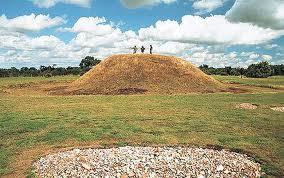
Thanks to Emily Peirson Webber for an eye opening trip around the Anglo-Saxon royal burial site ar Sutton Hoo.
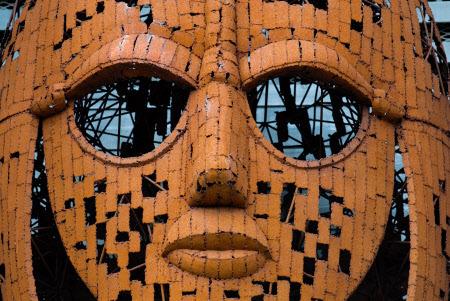
The striking Anglo Saxon helmet motif on the front of the exhibition hall at Sutton Hoo, the Anglo-Saxon royal burial site, Weybridge, Suffolk © National Trust Images/Ian Shaw
http://www.nationaltrust.org.uk/sutton-hoo/
Despite being one of the greatest archaeological discoveries of all time, Sutton Hoo will always remain a mystery. The Anglo-Saxon burial mounds which populate this Suffolk estate have rested enigmatically for over a millennium, though since their discovery in 1939 many people have tried to interpret their significance. The site now houses a modern exhibition hall and shop, as since 1998 it has been under the stewardship of the National Trust.
We visited Sutton Hoo on a sunny Saturday afternoon, and were at once taken aback by the calm and beguiling air of the unknown that enshrouds the whole area.
Upon approach you are met with the magnificent exhibition hall, which has been constructed in a sympathetic style, to fit in with the surrounding landscape. To enter the hall visitors walk beneath an imposing reproduction of the Sutton Hoo mask.
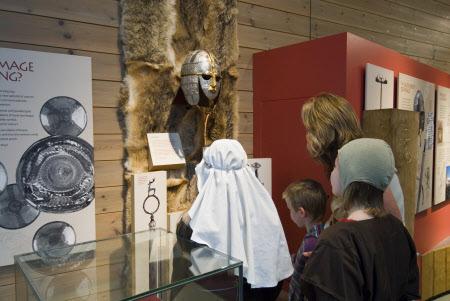
Visitors in the exhibition hall at Sutton Hoo © National Trust Images/Ian Shaw
Inside the exhibition centre, there is a comprehensive yet family-friendly review of what we know of life and death in the Anglo-Saxon era. In the center there is a life-size recreation of the burial chamber which archaeologists uncovered within the most impressive burial mound, housed within an Anglo-Saxon ship. It is popularly believed that this mound was the final resting place of the Raedwald, King of East Anglia in c.625 AD.
The famous tale of Beowulf features three funerals which describe the Anglo-Saxon practice of mound burial, and one in particular, the funeral of Scyld Scefing, features the burial of the King of the Danes in his boat, surrounded by his many worldly possessions. The parallels between Beowulf and the findings at Sutton Hoo are touched upon within the exhibition and add an additional layer of intrigue.
In the treasury you can see replica riches and some of the original finds from the burial sites – it is incredible to imagine these magnificent examples of ancient craftsmanship residing below the earth for so many years, undiscovered.
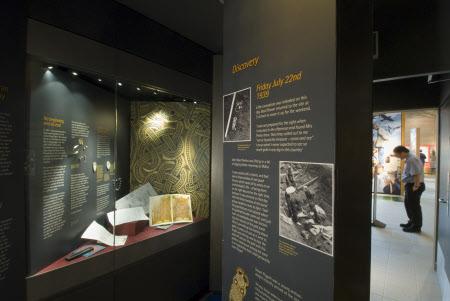
Inside the exhibition hall at Sutton Hoo© National Trust Images/Ian Shaw
After leaving the visitor centre, you take a short scenic walk to the home of Edith Pretty, whose patronage enabled the archaeologist Basil Brown to undertake excavation of the site, which rested on her 255 acre estate. Pretty’s home has been restored to its 1930s glory, and presents the opportunity to imagine the heyday of archaeology, during this wonderful era of discovery.
Outside you can wander around the burial ground: the exposed fields overlooking the river Deben are a perfect backdrop for such contemplative exploration.
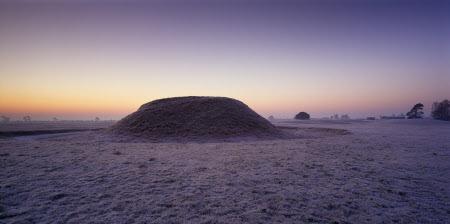
View looking towards a large burial mound at Sutton Hoo on a frosty dawn morning © National Trust Images/Joe Cornish
What is unusually refreshing about Sutton Hoo is that the National Trust enables visitors to embrace factual uncertainty, without the pressing urge for explanation which so often accompanies historical sites of such magnitude. It is enough to bear witness to this haunting spectacle, and to allow the silent mounds to tell their own story. It is a site unlike any other, and long may it continue to inspire the imagination.
Location: Woodbridge, Suffolk, IP12 3DJ
Entry Fee: £7.15
